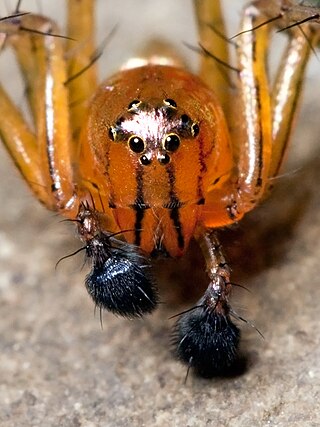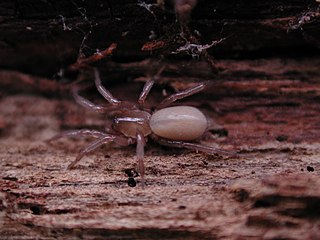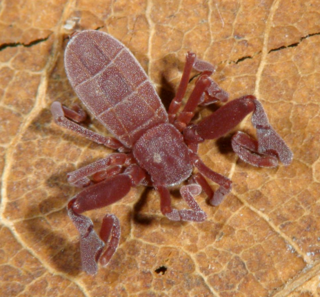
Arachnida is a class of joint-legged invertebrate animals (arthropods), in the subphylum Chelicerata. Arachnida includes, among others, spiders, scorpions, ticks, mites, pseudoscorpions, harvestmen, camel spiders, whip spiders and vinegaroons.

Pseudoscorpions, also known as false scorpions or book scorpions, are small, scorpion-like arachnids belonging to the order Pseudoscorpiones, also known as Pseudoscorpionida or Chelonethida.

Amblypygi is an ancient order of arachnid chelicerate arthropods also known as African cave-dwelling spiders, whip spiders and tailless whip scorpions. The name "amblypygid" means "blunt tail", a reference to a lack of the flagellum that is otherwise seen in whip scorpions. Amblypygids possess no silk glands or venomous fangs. They rarely bite if threatened, but can grab fingers with their pedipalps, resulting in thorn-like puncture injuries.

Ricinulei is a small order of arachnids. Like most arachnids, they are predatory, eating small arthropods. They occur today in west-central Africa (Ricinoides) and the Neotropics as far north as Texas. As of 2021, 91 extant species of ricinuleids have been described worldwide, all in the single family Ricinoididae. In older works they are sometimes referred to as Podogona. Due to their obscurity they do not have a proper common name, though in academic literature they are occasionally referred to as hooded tickspiders.

A book lung is a type of respiration organ used for atmospheric gas exchange that is present in many arachnids, such as scorpions and spiders. Each of these organs is located inside an open ventral abdominal, air-filled cavity (atrium) and connects with the surroundings through a small opening for the purpose of respiration.

Pedipalps are the second pair of appendages of chelicerates – a group of arthropods including spiders, scorpions, horseshoe crabs, and sea spiders. The pedipalps are lateral to the chelicerae ("jaws") and anterior to the first pair of walking legs.

Cybaeidae is a family of spiders first described by Nathan Banks in 1892. The diving bell spider or water spider Argyroneta aquatica was previously included in this family, but is now in the family Dictynidae.

Ralph Vary Chamberlin was an American biologist, ethnographer, and historian from Salt Lake City, Utah. He was a faculty member of the University of Utah for over 25 years, where he helped establish the School of Medicine and served as its first dean, and later became head of the zoology department. He also taught at Brigham Young University and the University of Pennsylvania, and worked for over a decade at the Museum of Comparative Zoology at Harvard University, where he described species from around the world.

Phanias is a genus of jumping spiders that was first described by Frederick Octavius Pickard-Cambridge in 1901. They are similar to members of Marpissa, but have three pairs of spines beneath the first tibia.

The Mexican blind brotula is a species of viviparous brotula endemic to Mexico, where it is found in sinkholes and caves. It is known as sak kay in Mayan and dama blanca ciega in Spanish. This cavefish grows to a standard length of 9.7 cm (3.8 in). It is the only known member of its genus.
The blind swamp eel is a species of fish in the family Synbranchidae. It is endemic to Mexico where it lives in cave systems and is known in Spanish as the anguila ciega. The International Union for Conservation of Nature has rated this cavefish as "endangered".

Cicurina, also called the cave meshweaver, is a genus of dwarf sheet spiders that was first described by Anton Menge in 1871. Originally placed with the funnel weavers, it was moved to the Dictynidae in 1967, then to the Hahniidae in 2017. The name is from the Latin root "cucur-", meaning "to tame".

Cryptocellus is an arachnid genus in the order Ricinulei, first described by John Westwood in 1874. It is native to the Neotropics.

Pseudocellus is an arachnid genus in the order Ricinulei, first described by Norman Platnick in 1980. It is native to the Neotropics.
Pseudocellus cookei is an arachnid species in the order Ricinulei. It occurs only in the cueva Jobitzinaj in Petén, Guatemala.

Hahnia is a genus of dwarf sheet spiders that was first described by C. L. Koch in 1841.
Wanops is a monotypic genus of Mexican goblin spiders containing the single species, Wanops coecus. It was first described by Ralph Vary Chamberlin & Vaine Wilton Ivie in 1938, and is only found in Mexico.
Anopsicus is a genus of cellar spiders that was first described by Ralph Vary Chamberlin & Vaine Wilton Ivie in 1938.
Drassinella is a genus of North American araneomorph spiders in the family Phrurolithidae, first described by Nathan Banks in 1904.













